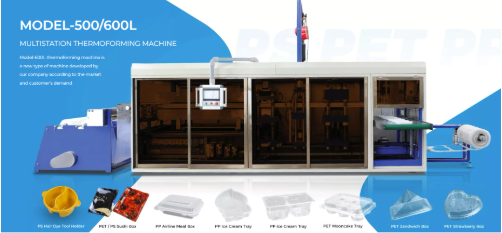Views: 0 Author: Site Editor Publish Time: 2025-09-24 Origin: Site
Thermoforming machines reshape modern packaging. They boost efficiency and cut production costs. In this article, you will learn how they enable precise, flexible, and cost-effective packaging solutions. Discover why every manufacturer considers a Thermoforming Machine essential today.
Thermoforming machines automate the heating, shaping, and cooling of plastic sheets. This reduces human error and boosts throughput. High-speed machines handle large volumes with minimal downtime. Manufacturers see improved consistency across all products.
Thermoforming allows intricate designs. Features like custom compartments, logos, and unique shapes are achievable. Machines adjust temperature, pressure, and cycle time to match the material and design.
Compared to injection molding, thermoforming has lower tooling costs. Quick setup and scalability make it ideal for small and large batches. Manufacturers can test prototypes and transition to full production without significant expenses.
Thermoforming machines handle thin and thick gauge plastics. Common materials include HDPE, PETG, ABS, PVC, and polycarbonate. Each material suits specific applications, from flexible food trays to rigid electronics enclosures.
Tips: Match material choice with production goals to optimize efficiency and reduce waste.

Vacuum forming is ideal for shallow or simple shapes. It suits food packaging, cosmetic trays, and medical containers. The plastic sheet conforms to the mold via suction, delivering consistent results.
Pressure forming applies air pressure to create detailed textures. It is suited for thicker plastics, high-precision automotive parts, and medical device casings.
Twin-sheet forming produces hollow or double-walled structures. Matched mold forming achieves tight tolerances for complex designs. Both are used in durable consumer products and industrial components.
Choosing a process depends on material thickness, part complexity, and volume. Thin gauge plastics favor vacuum forming, while thick or intricate parts require pressure or matched mold methods.
Tips: Conduct a trial run to confirm the best forming method for your product.
Thermoforming machines create trays, clamshells, and containers. They ensure food safety, maintain freshness, and enhance shelf appeal. Custom designs improve consumer experience.
Machines produce sterile, protective packaging. Blister packs, trays, and clamshells safeguard delicate medical devices. FDA-compliant plastics ensure regulatory standards are met.
Thermoforming machines produce protective inserts and casings. Precision ensures parts remain secure during shipping. Electronics are less prone to damage.
Thermoforming allows visually striking containers for cosmetics. Custom compartments and shapes enhance branding and consumer appeal.
Tips: Packaging quality directly affects consumer perception and product safety.
Low tooling and fast cycle times reduce expenses. Large-scale production becomes affordable. Thermoforming remains competitive even for high-volume orders.
Rapid prototyping allows faster product launches. Design adjustments are simpler compared to traditional molding.
Machines can use recycled plastics and reduce waste. Thinner plastics decrease material consumption, aligning with environmental goals.
Consistent heating and precise forming reduce defects. Surface finish and dimensional accuracy meet strict standards.
Tips: Consider integrating recycled materials to improve ESG compliance and reduce costs.
Uneven heating can warp plastic. Using high-quality machines ensures uniform temperature. Proper mold design reduces defects.
Molds face high pressure and heat. Durable molds and regular maintenance extend lifespan and ensure product consistency.
Not all plastics suit thermoforming. Manufacturers must choose materials based on strength, flexibility, and end-use requirements.
Excess trim and defective parts increase waste. Regrind systems and take-back programs minimize environmental impact.
Tips: Track material loss per batch to identify efficiency improvements.
Sensors and machine learning optimize heating, pressure, and cycle time. Real-time monitoring reduces errors and improves efficiency.
Robotic arms handle loading, unloading, and packaging. Fully automated lines reduce human error and speed up production.
Biodegradable plastics, recycled sheets, and energy-efficient machines are on the rise. Sustainability drives both consumer preference and regulatory compliance.
Data-driven production allows predictive maintenance and enhanced decision-making. Machines adjust to production demands dynamically.
Tips: Investing in IoT-enabled machines ensures long-term competitiveness.
Assess batch size, part complexity, and material thickness. Match machine capability to production needs.
Consider cycle time, precision, automation, and flexibility. Advanced features can improve cost-effectiveness and reduce downtime.
Weigh upfront costs against savings from speed, waste reduction, and lower labor. Cost-effective thermoforming packaging solutions offer long-term value.
Partner with experienced manufacturers. Reliable support ensures smooth integration, maintenance, and training. A strong vendor relationship improves uptime and reduces troubleshooting time.
Thermoforming Machine plays a vital role in modern packaging. It improves efficiency and lowers costs while allowing flexible designs. MINGDU offers advanced thermoforming solutions. Their machines deliver precision, sustainability, and high-quality packaging across industries.
A: A Thermoforming Machine shapes plastic sheets into packaging, offering cost-effective thermoforming packaging solutions for many industries.
A: It provides faster cycles, lower tooling costs, and cost-effective thermoforming packaging solutions.
A: It reduces waste and supports recycled plastics, making cost-effective thermoforming packaging solutions possible.